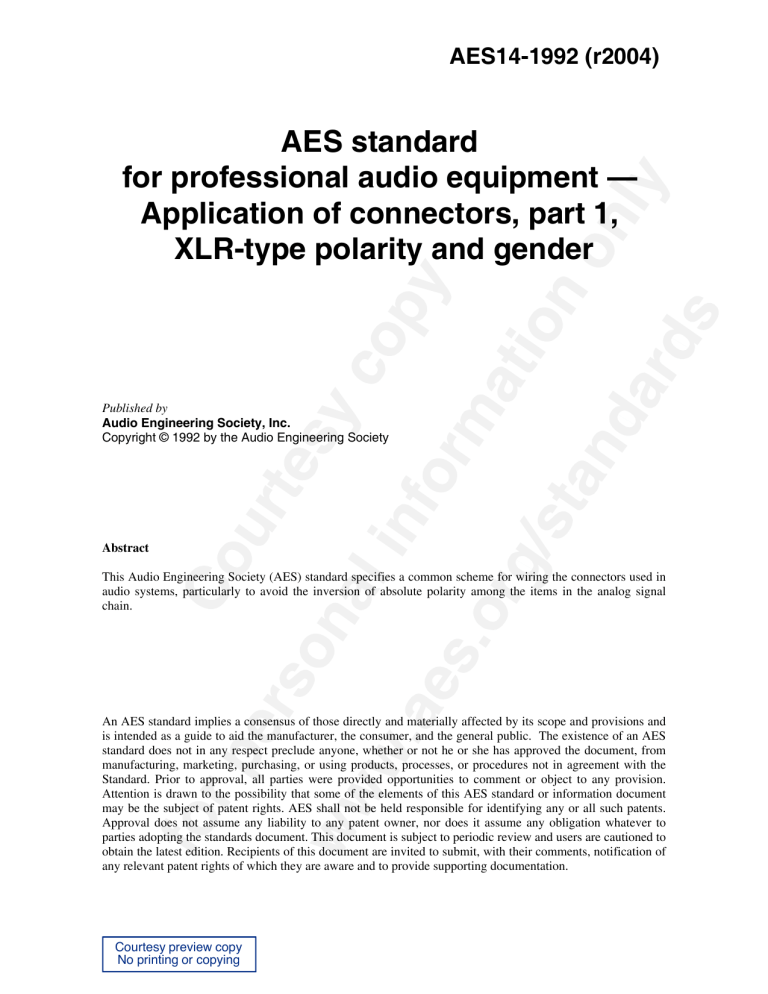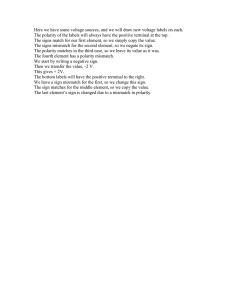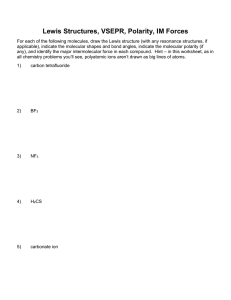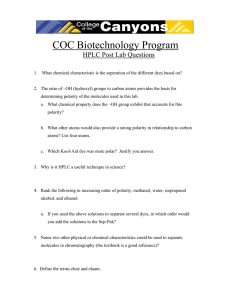
AES14-1992 (r2004) AES standard for professional audio equipment — Application of connectors, part 1, XLR-type polarity and gender Published by Audio Engineering Society, Inc. Copyright © 1992 by the Audio Engineering Society Abstract This Audio Engineering Society (AES) standard specifies a common scheme for wiring the connectors used in audio systems, particularly to avoid the inversion of absolute polarity among the items in the analog signal chain. An AES standard implies a consensus of those directly and materially affected by its scope and provisions and is intended as a guide to aid the manufacturer, the consumer, and the general public. The existence of an AES standard does not in any respect preclude anyone, whether or not he or she has approved the document, from manufacturing, marketing, purchasing, or using products, processes, or procedures not in agreement with the Standard. Prior to approval, all parties were provided opportunities to comment or object to any provision. Attention is drawn to the possibility that some of the elements of this AES standard or information document may be the subject of patent rights. AES shall not be held responsible for identifying any or all such patents. Approval does not assume any liability to any patent owner, nor does it assume any obligation whatever to parties adopting the standards document. This document is subject to periodic review and users are cautioned to obtain the latest edition. Recipients of this document are invited to submit, with their comments, notification of any relevant patent rights of which they are aware and to provide supporting documentation. Courtesy preview copy No printing or copying AES14-1992 (r2004) –2– Contents Section Page Foreword ......................................................................................................................................................... 3 1 Scope ............................................................................................................................................................. 4 2 Object............................................................................................................................................................. 4 3 Definitions ..................................................................................................................................................... 4 4 Connector usage............................................................................................................................................. 4 4.1 Contact designation and gender.................................................................................................................. 4 4.2 Contact pin designation .............................................................................................................................. 4 Tables 1 Connector designations and applications....................................................................................................... 5 2 Connectors pin designations .......................................................................................................................... 5 5 Normative references..................................................................................................................................... 5 Courtesy preview copy No printing or copying 2004-03-03 printing AES14-1992 (r2004) –3– Foreword [This Foreword is not a part of the AES standard for professional audio equipment — Application of connectors, part 1, XLR-type polarity and gender, AES14-1992 .] This document has been prepared by the Working Group on Connectors and Polarity, a working group of the Audio Engineering Society Standards Committee. It is designed in the public interest to eliminate misunderstandings that have existed for about 40 years among manufacturers, consultants, purchasers, and users of the XLR-type connector, and thus to facilitate integration of systems. While based on IEC 268-12, Sound System Equipment, Part 12: Application of Connectors for Broadcast and Similar Use, this document clarifies items considered by the committee to be ambiguous in the IEC document. The document was prepared by the working group at open meetings held entirely at AES conventions, with the participation or consultation, or both, of manufacturers and users of audio connectors including major manufacturers and users from Australia, Europe, Japan, and the USA. The group considered the arguments for the two conflicting wiring conventions for the 3-pin XLR connector. Both designate pin 1 as the screen (shield) or ground connection. They differ on the assignments of pins two and three. The connector, first manufactured in the USA by Cannon Electric Co., was used by Ampex Corp. in 1950 with the pin-2-return, pin-3-positive convention. Subsequently, the convention was adopted by other USA companies. The logic of the convention is that the sequence from pin 1 to pin 3 is from "lowest" to "highest" polarity, and that because pin 3 of the XLR is asymmetrically placed, it is most easily identified, and should therefore carry positive polarity. Others have argued that differences between the dynamics of input and output transducers should similarly be reflected in the pin connections. Also around 1950 other USA manufacturers, including Ampex's then principal competitor, Magnecord Inc., adopted the pin-2-positive polarity, pin-3-return convention. It may be noted that Magnecord provided its line outputs on barrier strips marked terminal 1 ground, terminal 2 return, and terminal 3 positive polarity, leading some users to wire associated line-level XLR connectors in the same manner. Nevertheless, the pin-2-positive polarity convention was adopted for all audio levels by manufacturers outside the USA and was standardized, explicitly for microphone use, in 1975 by the International Electrotechnical Commission in its Publication 268, Part 12. The USA National Committee of IEC did not object to approval of the standard. The convention was subsequently approved for all applications by the Society of Motion Picture and Television Engineers in its Polarity for Analog Audio Magnetic Recording and Reproduction, RP-134-1986, and by the European Broadcast Union in its Conservation of the Polarity of Audio Signals in Radio and Television Production Installations, EBU Technical Recommendation R50-1988. In its deliberations, the AES working group determined that a considerable majority of manufacturers and users in the USA are now following this convention. The group also determined that the designation XLR is now generic and carries no proprietary restrictions on its use. The group concluded that, although there are valid historical and engineering arguments for pin-3-positive, the pin-2-positive convention is now widely standardized and commercially used and must therefore be recognized. A high priority of the AES Standards Committee is the establishment of guides for uniform practice throughout the world. Particularly because current technology has blurred distinctions among different levels and applications, accepting both conventions would mean having two opposite conventions, which is to say no standard at all. The following individuals have contributed to the preparation of this document: Dennis Bohn, Richard Greiner, Tsukasa Hara, Randall Hoffner, Irving Joel, J. G. McKnight, Daniel Queen, Ken Smalley, J. Steven Smulian, Ronald D. Streicher, David Walsfra, Phil Wilton, and John Woram. IRVING JOEL, Chairman, AES Standards Committee WG-03 Working Group on Connectors and Polarity 1990 December The American National Standards Institute version of this standard has not been reprinted and remains available as ANSI S4.43-1991. Courtesy preview copy No printing or copying 2004-03-03 printing AES14-1992 (r2004) –4– AES standard for professional audio equipment — Application of connectors, part 1, XLR-type polarity and gender 1 Scope This standard shall apply to three- and five-pin circular connectors, commonly and generically known as XLRtype, used for the interconnection of all categories of sound system components for professional audio, commercial, recording, broadcast, and similar applications, regardless of function, type, or level of the signal. It specifies the application and polarity of analog signals for these connectors. This standard does not pertain to the dimensions of the connectors. The standard is based on IEC 268-12, Sound System Equipment, Part 12: Application of Connectors for Broadcast and Similar Use. NOTE – Use of this connector may be restricted by safety regulations. 2 Object In sound systems it is often necessary to connect pieces of equipment from different manufacturers. This standard provides a common scheme for wiring the connectors used—particularly to avoid the inversion of absolute polarity among the items in a signal chain. 3 Definitions 3.1 Positive sound pressure shall designate that portion of the sound wave during which the pressure is in excess of the atmospheric ambient. 3.2 Positive polarity shall designate an electrical signal voltage which acquires a potential that has a phase angle within 90 degrees with respect to a positive sound pressure peak. 3.3 Positive-polarity terminal shall be that terminal on which a positive signal shall be measured with respect to the oppositely polarized terminal when a positive-polarity signal is applied as observed with an oscilloscope or similarly functioning instrument. 3.4 Return terminal shall be that terminal which is polarized opposite to the positive-polarity terminal, that is, the negative-polarity terminal. 3.5 Positive-supply terminal shall be that terminal which carries the positive voltage of a direct-current microphone power supply. 3.6 Negative-supply terminal shall be that terminal which carries the negative voltage of a direct-current microphone power supply. 4 Connector usage 4.1 Contact designation and gender shall be as shown in table 1. 4.2 Connector pin designations shall be as shown in table 2. Courtesy preview copy No printing or copying 2004-03-03 printing AES14-1992 (r2004) –5– Table 1. Connector designations and applications. Pin connector (male) Equipment output 3 Socket connector (female) Equipment input 1 5 Pin connector (male) Equipment output 2 4 Socket connector (female) Equipment input 1* 2 3 *Connector numbers are as seen on the mating face of the pin connector. Application and supply Single-channel, balanced Single-channel, unbalanced Single-channel, balanced, phantom supplied Single-channel, balanced, A-B supplied Two-channel, balanced 1 Table 2. Connectors pin designations. Contact 2 3 4 5 Screen (shield) Screen and return Screen and negative supply Screen Positive Return polarity Positive Note 1 polarity Positive Return; polarity; positive supply positive supply Positive Return; polarity; negative positive supply supply Screen Left-channel Left-channel Right-channel Right-channel positive return positive return polarity polarity Two-channel, Screen and Left-channel Note 1 Right-channel Note 1 unbalanced return positive positive polarity polarity Two-channel, Screen and Left-channel Left-channel Right-channel Right-channel balanced, negative positive return; positive positive return; positive phantom supplied supply polarity; supply polarity; supply positive supply positive supply Two-channel Screen Left-channel Left-channel Right-channel Right-channel balanced, positive return; positive return; polarity; negative suply polarity; negative A-B supplied positive supply positive supply supply Note 1. If an unbalanced amplifier input is to accept a balanced microphone, contact 3 (or 3 and 5) of the input shall be connected to contact 1. 5 Normative references Sound System Equipment Part 12: Application of Connectors for Broadcast and Similar Use, IEC 268-12 (1987), International Electrotechnical Commission, Geneva, Switzerland. Courtesy preview copy No printing or copying 2004-03-03 printing





